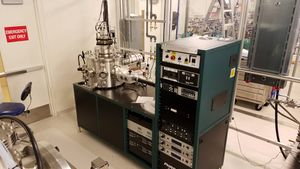Sputter 5 (AJA ATC 2200-V)
| |||||||||||||||||||||
About
The Eight-Target DC/RF Sputtering System, built by AJA International uses planar magnetron sources. The sputter guns are in-situ tiltable modules that allow for maintaining uniformity control at various sample heights. Cross contamination between sources is minimized by using a "chimney" configuration with very narrow source to shutter gaps. Uniformity better than 2% is achieved for various sample heights. 4 DC and 1 RF power supplies allow for co-deposition of materials as well as the sputtering of a wide variety of materials. The system is recipe driven and computer controlled for reproducible results.
The deposition chamber is loadlocked, with automatic wafer transfer, providing for fast substrate transfer and consistent, low base pressure. Venting and evacuation are automated with a 1200 l/s turbo pump achieving < 5 E-8T ultimate pressure. A VAT gate valve is used for process pressure control independent of gas flow. Flow rates are controlled with standard mass flow controllers. Gun power supplies include: 300W DC, 13.56 Mhz 300W RF, and a 150W substrate RF supply for in-situ substrate biasing and pre-cleaning.
Up to 6" round wafer sizes can be accommodated in the system. Smaller substrates are clip mounted onto the carriers, while round wafers have drop-in pocket carriers or clips carriers.
Other materials, such as ITO, Si, Al, Zr, etc. can be reactively RF sputtered in an O2 or N2 environment to produce metal-oxides or nitrides. Argon is used for the sputter gas, with N2 and O2 used for reactive sputtering.
Samples can be heated to 800°C.
Procedures
Procedures are similar to Sputter #3 and Sputter #4.
Recipes
- Recipes > Vac. Dep. > Sputtering Recipes > Sputter #5
- See the Sputter #5 SignupMonkey Page for a list of currently installed sputter targets.
